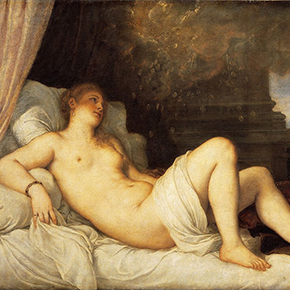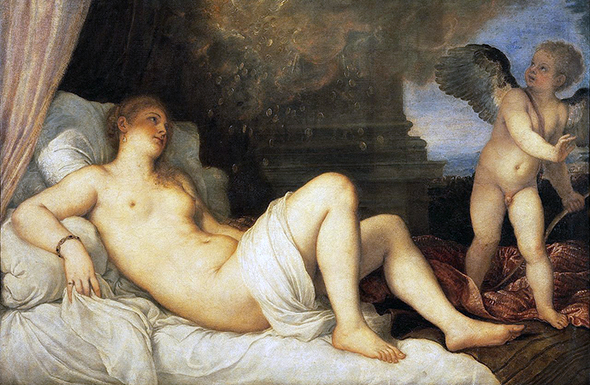To celebrate the commencement of Italy’s presidency of the Council of the European Union (EU), the Italian government is bringing to Washington’s National Gallery of Art, one of the most sensual paintings of the Italian Renaissance—Titian’s Danaë (1544–1545).
 “We are very pleased to continue our excellent cooperation with a prestigious institution such as the National Gallery in Washington on the occasion of the presentation of Titian’s Danaë,” said the Ambassador of Italy to the United States, Claudio Bisogniero. “We are particularly delighted that this exhibition will launch in the U.S. the Italian Presidency of the European Union, an important opportunity also to further strengthen the friendship between the two sides of the Atlantic.”
“We are very pleased to continue our excellent cooperation with a prestigious institution such as the National Gallery in Washington on the occasion of the presentation of Titian’s Danaë,” said the Ambassador of Italy to the United States, Claudio Bisogniero. “We are particularly delighted that this exhibition will launch in the U.S. the Italian Presidency of the European Union, an important opportunity also to further strengthen the friendship between the two sides of the Atlantic.”
“The richness of the Gallery’s collection of Venetian 16th-century painting includes the largest holdings in the United States of works by Titian and his studio, with 13 paintings, eight prints, and two drawings,” said Earl A. Powell III, director, National Gallery of Art. “We are most grateful for the generosity of the Capodimonte Museum in Naples and are pleased to present the Danae in such close proximity to other related works by Titian, celebrating the genius and legacy of one of the world’s most influential painters.”
The Danaë is one of several examples of the genre of erotic mythologies in Western art popularized by Titian. Two other examples of this genre by Titian from the Gallery’s permanent collection—Venus with a Mirror (c. 1555) and Venus and Adonis (c. 1560)—are also on view in the West Building, in gallery M-23.
“The Special Superintendency for Historic, Artistic and Ethno-anthropologic Properties of the City of Naples Museum Hub and the Palace of Caserta is particularly pleased to collaborate in this extraordinary event for promoting the excellence of Italian culture in the United States,” said Fabrizio Vona, superintendent, Cultural Heritage for the City and the Museums of Naples and the Royal Palace of Caserta.
The painting will be on loan from the Capodimonte Museum, Naples— and will be on view July 1 through November 2, 2014, in the West Building of the National Gallery of Art. Italy’s Presidency of the Council of the European Union runs from July 1 through December 31, 2014.

Titian (c. 1488/90–1576)
In a career that spanned more than 70 years, Tiziano Vecellio (called Titian in English) was the greatest force in Venetian Renaissance painting. Born around 1490 in the town of Pieve di Cadore in the Italian Alps, Titian moved at an early age to Venice to study art. After training briefly with a mosaicist, he studied with Giovanni Bellini, the leading painter of his generation. Titian was influenced not only by Bellini’s use of rich color but also by the pastoral and mythological scenes of fellow Bellini pupil Giorgione.
By 1510, Titian had established himself as an independent master and, after Bellini’s death, he was appointed official painter to the Venetian Republic. Following a number of commissions for the courts of Ferrara, Mantua, and Urbino, Titian’s fame spread internationally. His patrons included the Holy Roman Emperor Charles V, Philip II of Spain, Francis I of France, and Pope Paul III.
Titian was a master in all painted genres. He produced dignified and insightful portraits, Madonnas of modesty and charm, playful mythological pictures, sensuous nudes, and meditative religious works. Titian died in 1576 and was buried in Santa Maria Gloriosa dei Frari, where his dramatic altarpiece, The Assumption of the Virgin (1516–1518), had been installed nearly 60 years before.
Danaë (1544–1545)
The loves of the gods were a favorite theme of Titian’s princely patrons. During the course of his long career, he became the greatest and most influential interpreter of these amorous episodes, drawn from Ovid’s Metamorphoses and other literary texts.
A celebration of the recumbent female nude, the Danaë depicts the legendary maiden, in bed and about to receive Jupiter, the king of the gods. Lured by reports of her beauty, Jupiter appears to her in the guise of a shower of gold coins.
Commissioned by Cardinal Alessandro Farnese, grandson of Pope Paul III, the painting was completed during a visit Titian made to Rome in 1545–1546. Wealthy and worldly, Alessandro Farnese was both a distinguished patron of the arts and a notorious womanizer with a mistress (a courtesan named Angela). At a time when ecclesiastics were under fire for their licentious and corrupt ways, it was prudent to transform an all-too-contemporary courtesan into a mythological figure whose nudity was sanctioned by classical precedent.
The Danaë was looted by German troops on behalf of Field Marshal Hermann Göring during the Second World War and was discovered afterward in the Austrian salt mine at Alt Aussee. The canvas was brought to the Munich Central Collecting Point by the so-called Monuments Men in 1945 and returned to the Italian government two years later.
SOURCE: NGA et al.


